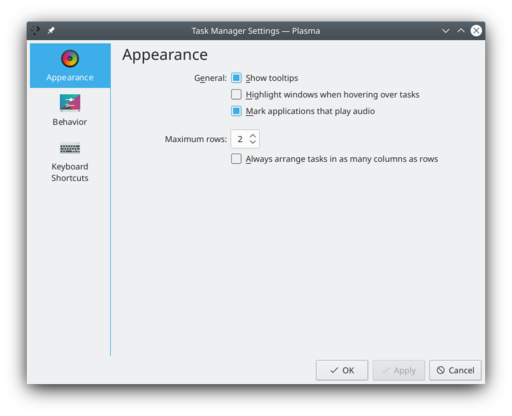Plasma/Tareas
El gestor de tareas de Plasma

El Gestor de tareas proporciona una acceso rápido a las aplicaciones en ejecución. Se encuentra en la sección central del panel. Si la ventana de una aplicación está situada detrás de otras ventanas o ha sido minimizada, puedes ponerla en primer plano y preparada para recibir entradas haciendo clic en su ficha del Gestor de tareas.
El elemento gráfico Gestor de tareas
El Gestor de tareas es en realidad un elemento gráfico, lo que significa que lo puedes colocar en cualquier lugar. Por ejemplo, podrías añadir un panel nuevo a (digamos) la parte superior de la pantalla y colocar el Gestor de tareas ahí, o podrías ponerlo en el escritorio si así lo quisieras. Incluso puedes tener varias copias en distintos lugares.
Siempre que inicies una aplicación verás una nueva ficha en el Gestor de tareas que muestra el icono de la aplicación y el título de la ventana que se abrió.
Si haces clic en la ficha correspondiente a la ventana activa esa ventana se minimizará. Si todavía quedan ventanas sin minimizar, entonces la situada delante del resto se convertirá en la ventana activa. Si haces clic en la ficha de una ventana minimizada se mostrará delante del resto de ventanas, y se convertirá en la ventana activa. Si haces clic en la ficha de una ventana que se encuentra detrás de otras, se traerá al frente delante de todas las otras ventanas, y se convertirá en la activa.
También puedes hacer clic con el botón derecho en una ficha para abrir un menú contextual, que ofrece varias opciones. Por ejemplo, puedes indicar en que escritorios virtuales se muestran las ventanas, o puedes cerrar las ventanas.

If you have many windows opened the tabs may be grouped. In that case you will see a number with a small arrow above in the right hand side of the tab. Clicking on such a tab will bring up a list of tabs for individual windows that you can use just like ordinary Task Manager tabs. Right-clicking a group gives you the option to close all windows in that group.
You can also activate windows by holding Alt down while pressing Tab one or more times. This way you browse through all windows whether displayed or minimized.
Configuration
To access the Task Manager settings menu, right-click on it and click . If you have troubles to click on it and not in one of its tasks, you can first click the panel toolbox, so wherever you click on the Task Manager will work.

There you can change its behavior. The following settings are particularly useful:
- Grouping and Sorting
- Grouping can be by program name, manually, or not at all. (You can also choose to only enable grouping if the taskbar is full.) Similarly, Sorting defaults to , but it can also be , , or .
- Only Show Tasks from the Current Desktop
- A checkbox on the Filters section.
- Have More than One Row on the Taskbar
- If you use many applications at one time you may find it advantageous to set and then .
- Showing or Hiding Tooltips
- A simple checkbox in the Appearance section of the page.

